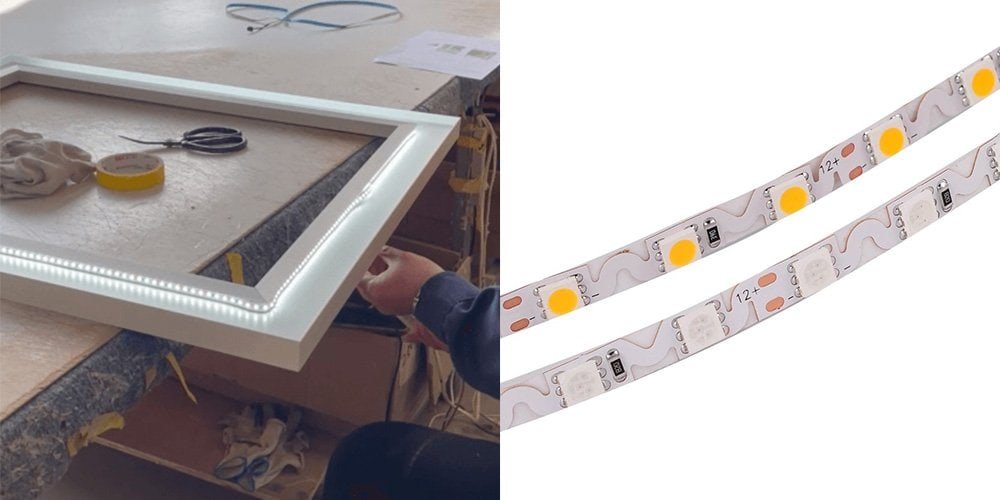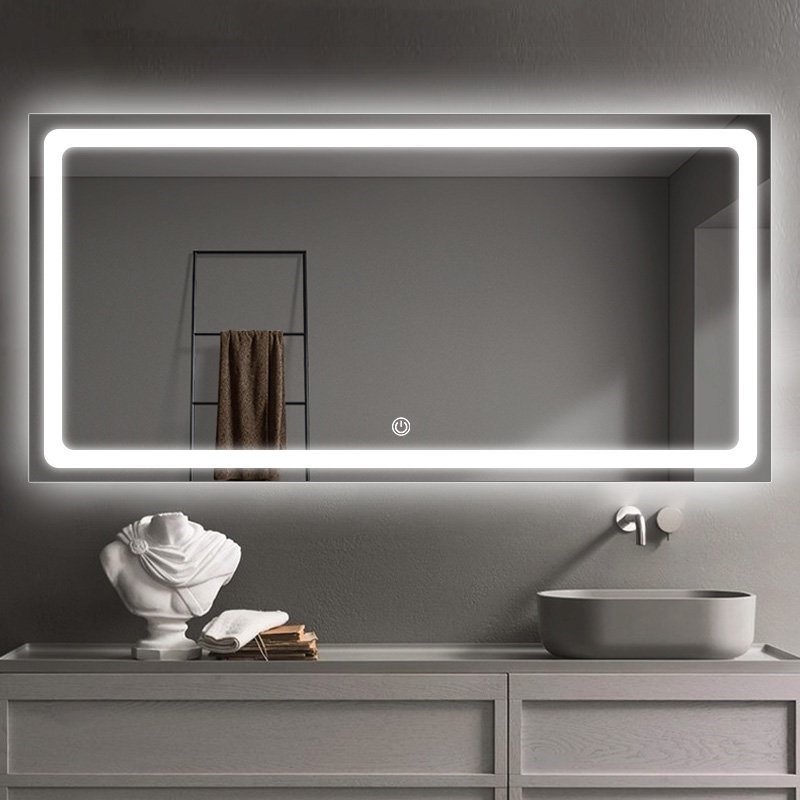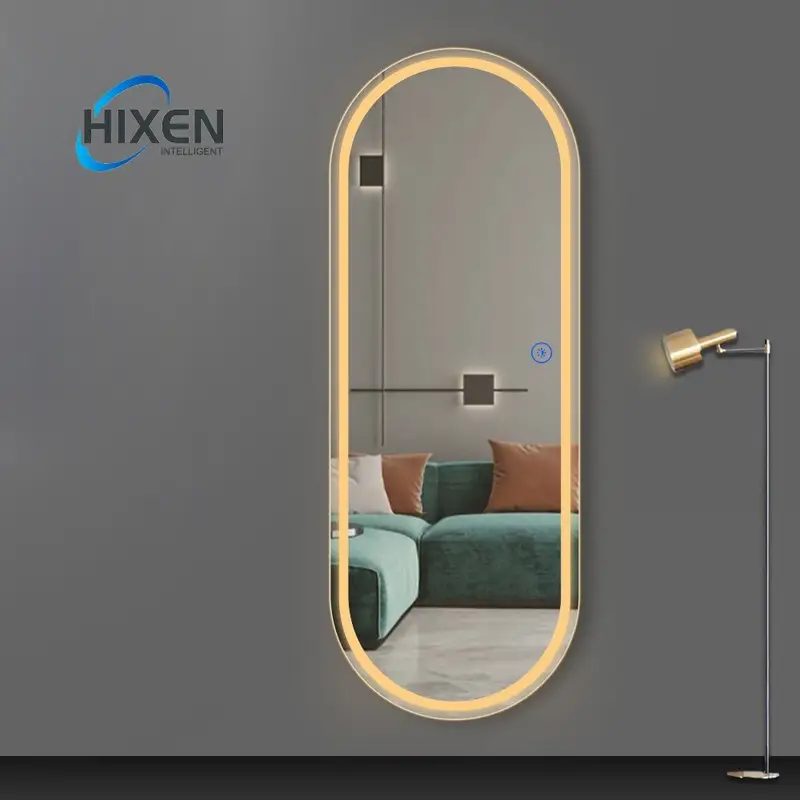|
Получение вашего Троицкий аудио Игрок готов ...
|
Why Won’t My LED Mirror Light Work? How to fix led mirror light?
First check that the power supply and light strip are working properly; if the power is on and the light strip is undamaged, then remove the switch cover and check for loose wires; also check that the controller is not damaged and that the wiring is not frayed. Depending on the location of the damage different ways to deal with it, if the problem persists, or you feel uncertain about dealing with these problems, it is best to seek professional help.
Below we will explain you how to fix led mirror light from different dimensions.

Common Causes of LED Mirror Light Failures
Понимание why your LED mirror stopped working is the first step toward fixing it. Several factors can contribute to LED mirror light failures:
1. Power Supply Problems
The most frequent cause of LED mirror malfunction is related to power supply issues. Your mirror’s LED system requires a stable power source to function properly. Voltage fluctuations or faulty power adapters can prevent the lights from working correctly.
2. Touch Sensor Malfunctions
Touch sensor malfunctions present another frequent challenge for LED mirror owners. These innovative controls add convenience and a modern touch to your mirror, but they’re susceptible to various environmental factors. Bathroom environments, particularly those with high humidity levels, can affect sensor performance over time. Кроме того, the accumulation of everyday substances like hairspray residue, cleaning products, and even natural skin oils can create an invisible barrier that interferes with the sensor’s functionality.
Modern LED mirrors often feature touch-sensitive controls. These sensors can become less responsive over time due to:
- Accumulated dirt and grime
- Moisture damage
- Electronic component wear
- Electromagnetic interference from nearby devices.
3. LED Strip Degradation
The degradation of LED strips themselves represents a more serious but less common issue. While manufacturers often advertise impressive lifespans ranging from 30,000 к 50,000 часы, real-world conditions can significantly impact these estimates. Factors such as bathroom humidity, temperature fluctuations, and usage patterns all play crucial roles in determining how long your LED strips will maintain optimal performance:
- Poor heat dissipation
- Manufacturing defects
- Electrical surges
- Environmental stress

How to fix led mirror light?
Before diving into complex repairs, try these straightforward solutions that often resolve common LED mirror issues:
1. Power Cycling
Power cycling, while seemingly simple, can effectively resolve many electronic glitches. Unplug your LED mirror from the power source and wait for 30 секунды. This simple reset can resolve many electronic issues by clearing any temporary glitches in the system. Plug it back in and test the lights.
2. Clean the Touch Sensor
Cleaning your mirror’s touch sensor requires a delicate approach. Using a slightly dampened microfiber cloth, gently wipe the sensor area using circular motions. Avoid harsh cleaning chemicals or excessive moisture, as these can potentially damage the sensitive electronic components beneath the surface. После уборки, thoroughly dry the area with a clean, soft cloth to prevent any moisture-related issues.
- Use a slightly damp microfiber cloth
- Gently clean the sensor area
- Dry thoroughly with a clean cloth
- Test the sensor after cleaning
3. Inspect Power Connections
Connection problems often develop gradually over time, making them easy to overlook. A thorough inspection of all power connections can reveal loose fittings or subtle damage that might be affecting your mirror’s performance. Examine the entire length of the power cord for any signs of wear, paying particular attention to areas where the cord might bend or face regular stress. Ensure the power plug fits snugly in the outlet and check for any discoloration around the connection points, which might indicate electrical issues requiring professional attention.
Examine all power connections for signs of damage or looseness:
- Check the power cord for fraying or breaks
- Ensure the plug fits securely in the outlet
- Look for any visible damage to the mirror’s power port
How do you fix LED lights behind a mirror?
The decision to replace LED mirror lights often comes after noticing persistent issues that simple fixes can’t resolve. Flickering lights that continue despite troubleshooting, dark sections in your LED strip, or noticeable color variations across the illuminated area typically indicate that replacement might be necessary. In many cases, these symptoms progressively worsen over time, starting subtly before becoming more pronounced and disruptive to your daily routine.
Signs Replacement is Required
- Flickering that persists after trying simple fixes
- Sections of LEDs that remain dark
- Significant color variation across the light strip
- Visible damage to LED components
When approaching LED replacement, proper preparation makes a significant difference in the success of your repair effort. Start by thoroughly documenting your existing setup – photographs of the current installation, including wire connections and LED strip positioning, prove invaluable during reassembly.
The replacement process requires careful attention to detail and proper safety precautions. Ensure you’re working with compatible replacement parts by noting your mirror’s model number and LED specifications before making any purchases.
The actual replacement procedure demands patience and methodical execution. Begin by completely disconnecting the mirror from its power source and allowing sufficient time for any residual electrical charge to dissipate. If your mirror is wall-mounted, you’ll likely need to remove it to access the LED housing properly.
Working in a well-lit area with plenty of space helps prevent accidents and ensures you can clearly see what you’re doing. Pay particular attention to how the original LED strips are secured and connected – manufacturers use various mounting methods and connection types that you’ll need to replicate with your replacement components.

Advanced Troubleshooting for Specific Issues
Touch sensor problems represent some of the most challenging LED mirror issues to diagnose and repair. These sophisticated components respond to minute electrical changes when your finger approaches the sensor area.
Факторы окружающей среды, including bathroom humidity and electromagnetic interference from nearby devices, can significantly impact sensor performance. A systematic approach to troubleshooting begins with eliminating potential external interference sources before moving on to more complex solutions.
Motion sensor malfunctions require a different troubleshooting approach altogether. These sensors rely on detecting changes in infrared radiation within their field of view. Understanding this fundamental principle helps explain why these sensors might activate unexpectedly or fail to respond when needed.
Regular cleaning of the sensor lens using appropriate methods proves crucial for maintaining reliable operation. In environments with changing temperature patterns or high humidity levels, motion sensors might require periodic sensitivity adjustments to maintain optimal performance.
Intermittent lighting issues often prove particularly frustrating because of their unpredictable nature. These problems frequently stem from loose connections that temporarily disconnect under certain conditions, such as minor vibrations or temperature changes.
Systematic testing under different environmental conditions can help identify patterns in the malfunction, providing valuable clues about the underlying cause. Long-term monitoring of when and how these issues occur helps narrow down potential causes and guides your repair strategy.
Maintenance Tips to Prevent Future Problems
| Maintenance Area | Task | Frequency |
|---|---|---|
| Regular Cleaning Protocol | Use appropriate cleaning solutions | As needed |
| Avoid harsh chemicals | Always | |
| Clean sensors | Monthly | |
| Remove dust regularly | Regularly | |
| Check for moisture accumulation | Regularly | |
| Moisture Prevention | Ensure proper ventilation | Always |
| Use exhaust fans during showers | During each shower | |
| Maintain appropriate room temperature | Always | |
| Apply anti-fog treatments when needed | As needed | |
| Address any bathroom humidity issues | As needed | |
| Electrical Maintenance | Inspect cords | Quarterly |
| Test ground fault protection | Quarterly | |
| Monitor for unusual operation | Regularly | |
| Keep connections clean | Regularly | |
| Document any changes in performance | As changes occur |
How Do You Fix LED Lights Behind a Mirror?
When the LED lights behind a mirror stop working, it’s often due to power supply issues, faulty wiring, or the lights themselves being damaged. To fix it:
- Check the Power Source: Ensure the mirror is plugged in and receiving power. Test the outlet with another device to rule out electrical issues.
- Inspect the Wiring: If the lights are not working but the mirror is powered, the wiring might be loose or disconnected. Carefully inspect the connections behind the mirror and secure any loose wires.
- Replace the LED Strip: If the LED strip is damaged or faulty, you can replace it. Be sure to buy the correct type of LED strip compatible with your mirror model.
Tip: Always turn off the power supply before attempting any electrical work on your LED mirror.
Can You Replace the Light in an LED Mirror?
Да, you can replace the light in an LED mirror. Обычно, LED mirrors use strips or panels that can be replaced individually. If the light is dim or not working, you can replace the LEDs with new ones of the same type and specifications. Here’s a general guide:
- Unplug the Mirror: Ensure safety first by unplugging the mirror.
- Remove the Back Panel: Use a screwdriver to remove the back panel and access the LED components.
- Replace the LEDs: Disconnect the old LED strip or panel and replace it with a new one.
Pro Tip: Make sure to check the warranty of your mirror. Many manufacturers offer replacement parts for their products.
Why Is My LED Mirror Light Not Working?
There are several common reasons why the LED light in your mirror might not be working. Some of these include:
- Power Supply Issue: The mirror may not be receiving enough power.
- Взорванный предохранитель: A blown fuse can cause the light to stop working.
- Faulty LED Strip: If one or more LEDs are malfunctioning, it can cause the entire strip to fail.
- Loose Connections: Wiring behind the mirror might have become loose or disconnected.
Решение: Troubleshoot by checking the power supply, inspecting the wiring, and replacing faulty components.
Can LED Mirrors Be Repaired?
Да, LED mirrors can usually be repaired. The most common repairs include replacing LED strips or panels, addressing power supply issues, or replacing damaged components such as the touch sensor or heating pad (if included). В некоторых случаях, depending on the extent of the damage, it may be more cost-effective to replace the mirror.

How Long Do LED Lighted Mirrors Last?
LED lighted mirrors are designed to last for many years. The lifespan of the LEDs depends on the quality of the lights used, but most LED strips last between 30,000 к 50,000 часы. If you use the mirror every day, that’s 10 к 15 годы.
Tip: Regular maintenance, such as cleaning the mirror and checking for any wiring issues, can help extend its lifespan.
Can LED Backlight Be Repaired?
Да, LED backlights can be repaired. If the backlight goes out, it could be the LED strip, the power supply, or the wiring. Обычно, replacing the LED strip is the easiest fix. If it’s something more complicated, you might need to get some professional help.
Do You Need an Electrician for LED Mirror Repairs?
If you’re just replacing an LED strip or fixing some loose wires, you probably don’t need an electrician if you’re comfortable working with electrical stuff. Однако, if it’s something more complicated like a power supply issue or something wrong with the internal circuitry, I would recommend you hire a certified electrician.
Safety Reminder: Always turn off the power to the mirror before attempting any repairs.
Can Broken LED Be Repaired?
Обычно, a broken LED can be repaired by replacing the individual light or the LED strip. If the problem is with the circuit board or the internal components, you might need to have it professionally repaired. For DIY repairs, you can usually replace the bad LED module.
Can You Use Windex on LED Mirrors?
Да, you can use Windex or glass cleaner on them. Just don’t spray it directly on the mirror. Spray it on a soft cloth and wipe the mirror gently. You don’t want to damage the electrical components behind the mirror. Don’t use anything abrasive that will scratch the surface either.

Заключение
Most LED mirror light problems can be resolved through proper troubleshooting and maintenance. Start with simple solutions like power cycling and cleaning before moving to more complex repairs. Remember that safety comes first – if you’re unsure about any repair step, consulting a professional is the wisest choice.
Regular maintenance and proper care can significantly extend your LED mirror’s lifespan and prevent many common issues. By following the guidelines in this troubleshooting guide, you can keep your LED mirror functioning properly for years to come.
Want to learn more about LED mirror maintenance and care? Subscribe to our blog for weekly tips and expert advice on maintaining your bathroom fixtures. For professional LED mirror solutions and custom designs, feel free to contact our team of experts.
- Просмотрите эту ссылку, чтобы проверить, как производятся зеркала.
- Просмотрите эту ссылку, чтобы увидеть, как выбрать зеркало в ванной комнате правильного размера?
- Чтобы найти топ 10 Поставщики светодиодного зеркала нажмите здесь.
- Чтобы узнать, как починить извитанное зеркало, нажмите здесь.
- Чтобы узнать, в чем разница между дорогостоящим зеркалом и дешевым зеркалом, нажмите здесь.
If you wanna know more about LED mirror, please feel free to contact us~
























